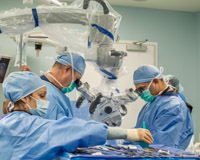Back and neck pain are among the most common reasons people visit their doctors, and in many cases, conservative treatments like physical therapy, medications, and lifestyle changes are enough to bring relief. But when pain becomes chronic and debilitating, and other treatments fail to provide relief, considering a spinal fusion surgery with an orthopedic surgeon may be necessary.
VIDEO: When is Spinal Fusion Necessary?
What is Spinal Fusion Surgery?
Spinal fusion is a procedure where two or more vertebrae are permanently joined together to stabilize the spine and reduce pain. Usually it’s not a first-line treatment, but it can be necessary for specific conditions. Spinal fusion surgery involves placing bone or a bone-like material between two spinal vertebrae. The bones grow together over time, eliminating movement between them. This procedure often includes the use of metal plates, screws, or rods to keep the vertebrae in place while the fusion heals.
The goal is to stabilize the spine and reduce pain caused by abnormal motion or nerve compression. While spinal fusion can limit mobility in the fused segment, many patients report a significant improvement in quality of life after getting the procedure.
 "When someone’s dealing with chronic back pain, nerve issues, or instability from things like a herniated disc, spinal fusion can sometimes be the right move. It’s typically used when other treatments haven’t brought enough relief, and the spine needs a little more support. Spinal fusion is like giving [your] spine some extra backup—it helps stabilize the area that's been causing pain by joining two or more bones together. Think of it like fixing a wobbly part of a bookshelf so it can hold strong again. [My] goal is to get you back to moving comfortably and living your life without that constant ache.
"When someone’s dealing with chronic back pain, nerve issues, or instability from things like a herniated disc, spinal fusion can sometimes be the right move. It’s typically used when other treatments haven’t brought enough relief, and the spine needs a little more support. Spinal fusion is like giving [your] spine some extra backup—it helps stabilize the area that's been causing pain by joining two or more bones together. Think of it like fixing a wobbly part of a bookshelf so it can hold strong again. [My] goal is to get you back to moving comfortably and living your life without that constant ache.
Grant Shifflett, MD | Minimally Invasive & Reconstructive Spine Surgeon
When is Spinal Fusion Necessary?
Spinal fusion is generally considered when:
- Non-surgical treatments have failed over the course of several months.
- Pain severely impacts daily activities and a patient’s quality of life.
- Spinal instability or deformity are present.
- There is a neurological deficit such as weakness or numbness.
Common Conditions Leading to Spinal Fusion
Some of the common conditions that may lead to spinal fusion include:
Lumbar Degenerative Disc Disease
Degenerative disc disease (DDD) is a condition where the discs between the vertebrae lose hydration and flexibility over time. In the lumbar spine (lower back), this can lead to instability, chronic back pain, or nerve impingement.
While many people with lumbar degenerative disc disease manage symptoms with conservative measures, spinal fusion may be considered when:
- Pain persists despite conservative treatments such as physical therapy, anti-inflammatory medications, and/or injections.
- Imaging shows a collapsed disc or instability.
- Nerve compression leads to sciatica, numbness, or weakness in the legs.
Lumbar fusion surgery helps stabilize the affected vertebrae and reduce pain caused by abnormal motion or nerve pressure.
Slipped Disc (Herniated Disc)
A slipped disc, also known as a herniated or ruptured disc, occurs when the soft inner material of a spinal disc pushes through its tougher outer shell. This can irritate nearby nerves and cause pain, numbness, or weakness.
Most slipped discs improve with conservative treatment like rest, physical therapy, and anti-inflammatory medications. However, surgery—including spinal fusion—might be necessary if:
- Pain is severe and unrelenting.
- There's loss of bladder or bowel control (a sign of cauda equina syndrome, which is a medical emergency).
- There's progressive neurological impairment.
- The disc has degenerated to the point of causing spinal instability.
In cases where a disc is removed (also called a discectomy), fusion may be used to prevent further instability in the spine.

 “Anterior cervical discectomy and fusion –mouthful [Laughs] – but it’s actually a pretty common surgery we use to treat things like herniated or worn-down discs in the neck. We make a small incision in the front of the neck, take out the damaged disc that’s pressing on nerves, and then fuse the bones to keep everything stable. Most people feel a big difference pretty quickly—less pain, better strength, and just an overall sense of relief. The fused part won’t move anymore, but that trade-off usually means way less discomfort. It’s not the first step we take, but when other treatments haven’t worked, it can be a real game-changer for patients."
“Anterior cervical discectomy and fusion –mouthful [Laughs] – but it’s actually a pretty common surgery we use to treat things like herniated or worn-down discs in the neck. We make a small incision in the front of the neck, take out the damaged disc that’s pressing on nerves, and then fuse the bones to keep everything stable. Most people feel a big difference pretty quickly—less pain, better strength, and just an overall sense of relief. The fused part won’t move anymore, but that trade-off usually means way less discomfort. It’s not the first step we take, but when other treatments haven’t worked, it can be a real game-changer for patients."
Bjorn Lobo, MD, FAANS | Neurosurgeon
Most Common Spinal Fusion: Anterior Cervical Discectomy and Fusion
One of the most common types of spinal fusion is anterior cervical discectomy and fusion. This surgery is used to treat herniated discs or degenerative disc disease in the cervical (neck) spine.
In an anterior cervical discectomy and fusion, the surgeon makes a small incision at the front of the neck, removes the damaged disc, and then fuses the adjacent vertebrae together. A bone graft and possibly a small metal plate are used to help the bones fuse.
This procedure is typically recommended when:
- A herniated or degenerated disc is compressing spinal nerves or the spinal cord.
- The patient experiences persistent neck pain, arm pain, or weakness.
- Non-surgical treatments have failed for at least 6–12 weeks.
 Most patients experience relief from nerve-related symptoms following an anterior cervical discectomy and fusion, though the fused segment will no longer move.
Most patients experience relief from nerve-related symptoms following an anterior cervical discectomy and fusion, though the fused segment will no longer move.
Before undergoing spinal fusion, patients should explore all non-invasive treatments, such as physical therapy and exercise, epidural steroid injections and anti-inflammatory and pain-relieving medications.
In some cases, an artificial disc replacement or minimally invasive spine surgery may be alternatives to traditional fusion, preserving more mobility and potentially speeding up recovery time.
It’s important to have a thorough discussion with a spine specialist to weigh the risks and benefits. Fusion is permanent and changes the biomechanics of the spine, which may put stress on adjacent segments.
Spinal fusion can be a life-changing procedure for those with persistent, debilitating spine conditions that do not respond to other treatments. Whether it’s through an anterior cervical discectomy and fusion for cervical disc issues, stabilization for lumbar degenerative disc disease, or fixing a slipped disc, fusion helps restore stability and relieve pain.
Pursuing a spinal fusion is not a decision to be taken lightly. Understanding the root cause of your pain, trying conservative options first, and talking to an expert spine specialist are all important steps to getting the best care for your specific needs. If you’re experiencing debilitating pain and are thinking of pursuing a spinal fusion, schedule a consultation with one of DISC’s leading specialists to talk about your treatment options.

About the author
discmdgroup DISC Sports & Spine Center (DISC) is a national leader in minimally invasive spine surgery, orthopedic surgery, and sports medicine care. Our spine surgeons set the standard in artificial disc replacement, spine fusion, discectomy, microdiscectomy and the full spectrum of spine procedures. The group’s orthopedic surgeons advance the state of joint preservation surgery and total joint replacement, including total knee replacement as well as total hip replacement. Our flagship surgery centers based in Newport Beach, Marina del Rey, and Carlsbad serve patients local to Los Angeles, Orange County and San Diego, as well as the rest of the country. Read more articles by discmdgroup.






